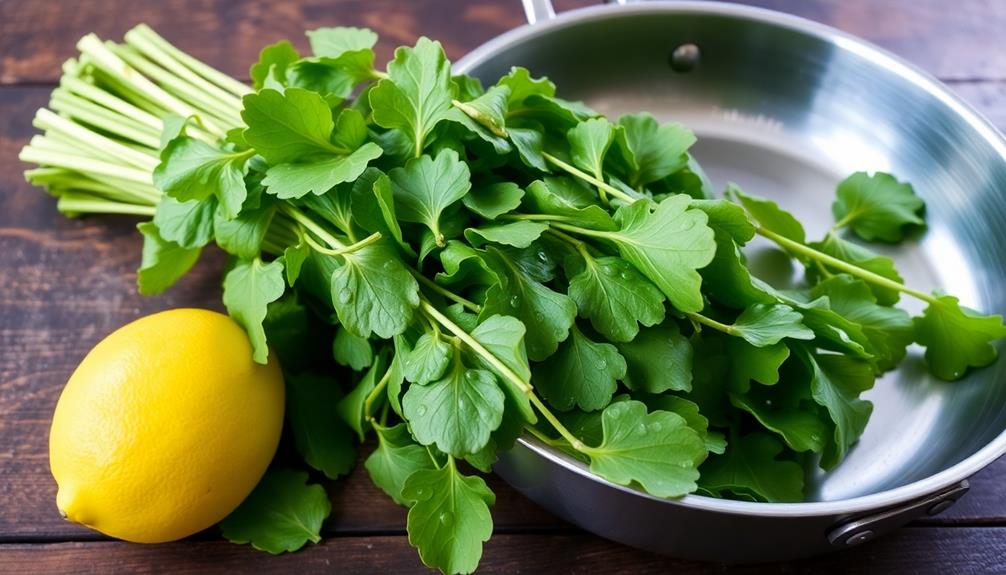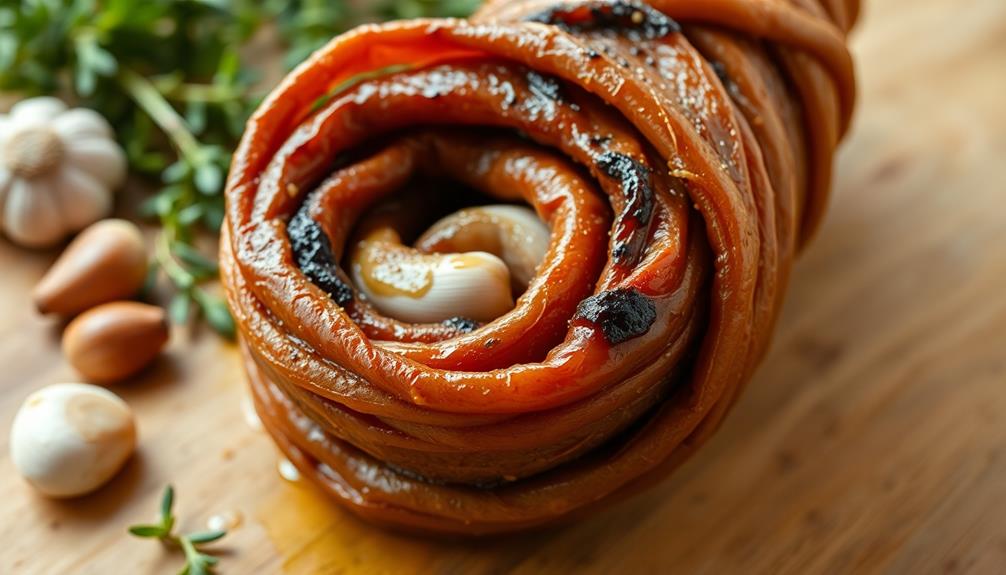Horta, the wild greens of the Mediterranean, have a rich cultural heritage. For generations, folks have foraged these nutrient-dense leaves, like dandelion and chicory, savoring their earthy, slightly bitter flavors. Sauté horta in olive oil with garlic, lemon, salt, and pepper to bring out their natural goodness. Enjoy them as a flavorful side or incorporate them into dishes like omelets and pastas. Harvesting horta connects you to nature's cycles, promoting ecological awareness and a deeper appreciation for the bounty all around. There's so much more to discover about these versatile wild greens – keep reading to uncover their full story!
Key Takeaways
- Horta refers to wild edible greens with origins in ancient Mediterranean civilizations, integral to traditional cuisines of regions like Greece, Italy, and Spain.
- Horta is known for its nutrient density, earthy, and slightly bitter flavor, often prepared simply by sautéing in olive oil with garlic and seasoning.
- Foraging for wild greens like horta fosters a connection to nature, promotes ecological awareness, and contributes to the preservation of cultural practices and food traditions.
- The process of harvesting, preparing, and consuming horta can create lasting memories, nurture curiosity about the natural world, and inspire environmental stewardship.
- Horta's significance extends beyond its culinary uses, as engaging with wild greens can lead to personal growth, a sense of purpose, and improved well-being.
History
The history of horta, or wild greens, can be traced back to ancient Mediterranean civilizations, where these nutrient-rich plants have long been an integral part of traditional cuisine.
For centuries, people living in regions like Greece, Italy, and Spain have foraged for and cultivated a variety of wild greens, each with its own unique flavor and texture. These greens, which include dandelion, chicory, and sorrel, weren't only valued for their culinary properties but also for their medicinal benefits.
Over time, the knowledge and appreciation of horta have been passed down through generations, with families often having their own secret foraging spots and cherished recipes.
Today, the rich history of horta continues to inspire chefs and home cooks alike, as they rediscover the wonders of these versatile and flavorful wild greens.
Recipe
Horta, also known as wild greens, are a staple in many Mediterranean cuisines. These nutrient-dense leaves are often foraged from the countryside and are prized for their earthy, slightly bitter flavor.
When cooked properly, horta can be a delightful and healthy addition to any meal, making it a great choice for those looking for economic benefits and cost savings in their cooking. Preparing horta is a simple process that allows the natural flavors of the greens to shine. The key is to gently cook the leaves to preserve their texture and nutrients while taming any bitterness.
Ingredients:
- 1 lb (450g) horta (wild greens), such as dandelion, sorrel, or chicory, washed and roughly chopped
- 2 tablespoons olive oil
- 1 clove garlic, minced
- 1 lemon, juiced
- Salt and pepper to taste
Instructions:
In a large skillet, heat the olive oil over medium heat. Add the minced garlic and cook for 1 minute, stirring constantly, until fragrant.
Add the chopped horta and sauté for 5-7 minutes, or until the greens are tender. Squeeze the lemon juice over the sautéed horta and season with salt and pepper to taste. Serve warm.
Additional Tips:
When selecting horta, look for fresh, vibrant leaves without any signs of wilting or discoloration.
If the greens are particularly bitter, you can try blanching them in boiling water for 1-2 minutes before sautéing to reduce the bitterness. Horta can be enjoyed as a side dish or incorporated into a variety of meals, such as omelets, pasta dishes, or as a topping for grilled meats or fish.
Cooking Steps
Carefully harvest your wild greens, making sure to rinse and drain them thoroughly.
Next, sauté the greens in a bit of olive oil, seasoning them with a sprinkle of salt and pepper.
Serve the hot, flavorful horta immediately for the best taste and texture.
Step 1. Harvest Wild Greens Carefully

Harvesting wild greens requires a deft touch. Tread carefully as you explore the lush, verdant landscape, keeping an eye out for the vibrant, tender leaves that will soon grace your plate.
Look for varieties that might inspire your next nail styling session, like those featuring romantic themes with reds and greens that can translate beautifully into nail art. Gently run your fingers along the stems, feeling for the most succulent, unblemished specimens. Pluck them with care, ensuring you leave the plant's roots intact so it can regrow and thrive.
Pay close attention to your surroundings, steering clear of areas that may have been sprayed with pesticides or other harmful chemicals. Identification is crucial – some wild greens are edible delights, while others can be toxic. Consult a field guide or an expert forager to learn which varieties are safe to consume.
Once you've gathered your bounty, give the leaves a thorough washing to remove any dirt or debris. With a little practice, you'll become a master of the hunt, filling your basket with nature's most nourishing wild treasures.
Step 2. Rinse and Drain Thoroughly
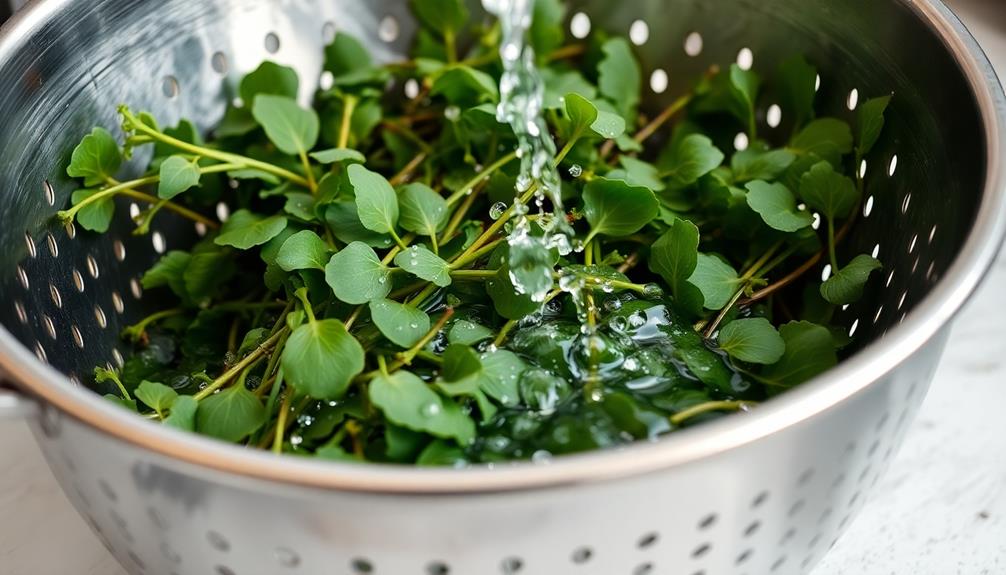
Once you've gathered your wild greens, it's time to give them a thorough rinse. Running them under cool, clean water is crucial to remove any dirt, debris, or bugs that may be clinging to the leaves.
Gently swish the greens around, being careful not to bruise or tear them. You may need to rinse them a few times to ensure they're squeaky clean.
After rinsing, it's important to drain the greens well. Grab a clean, dry kitchen towel or paper towels and gently pat the leaves dry. You don't want any excess moisture, as that can lead to wilting or spoilage later on.
If the greens are still a bit damp, you can also spin them in a salad spinner to remove the last few droplets.
With your fresh, clean wild greens ready to go, you can now move on to the next step in the cooking process. Properly rinsing and draining these delicate leaves will ensure they stay vibrant and flavorful throughout your meal.
Step 3. Sauté Greens in Olive Oil

Having thoroughly rinsed and drained the wild greens, you'll want to sauté them in a generous amount of olive oil.
Heat a large skillet over medium heat and add a few tablespoons of high-quality olive oil. Once the oil is shimmering, carefully add the greens, making sure they're in an even layer.
Sauté the greens, stirring occasionally, until they become tender and wilted, about 5-7 minutes. The greens will release moisture as they cook, so you may need to adjust the heat to maintain a gentle sizzle.
As the greens sauté, the olive oil will infuse them with a rich, nutty flavor. The heat will also help to soften any tough stems or leaves, making the entire dish more tender and enjoyable to eat.
Be sure to season the greens with a pinch of salt and pepper, to taste, as they cook. This simple preparation allows the natural flavors of the wild greens to shine.
Step 4. Season With Salt and Pepper
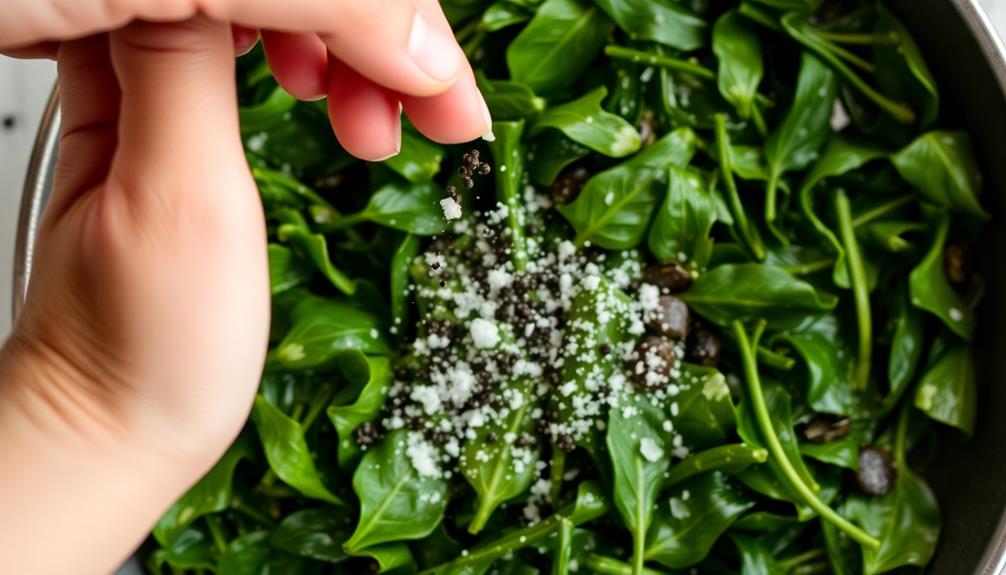
As the greens sauté to a tender, wilted state, season them with a pinch of salt and pepper. The salt will enhance the natural flavors, while the pepper adds a subtle kick.
Gently sprinkle the seasonings over the greens, using your fingers to lightly distribute them throughout. You'll notice the aroma start to bloom, filling the air with an earthy, herbal scent. Take a moment to inhale deeply, savoring the moment.
Now, use a pair of tongs or a spoon to toss the greens, ensuring the salt and pepper are evenly coated. The greens should glisten with a light sheen, ready to be enjoyed.
This simple seasoning elevates the dish, allowing the vibrant flavors of the horta to shine. With just a few dashes of salt and pepper, you've transformed these humble wild greens into a delightful, flavorful side.
Step 5. Serve Immediately While Hot
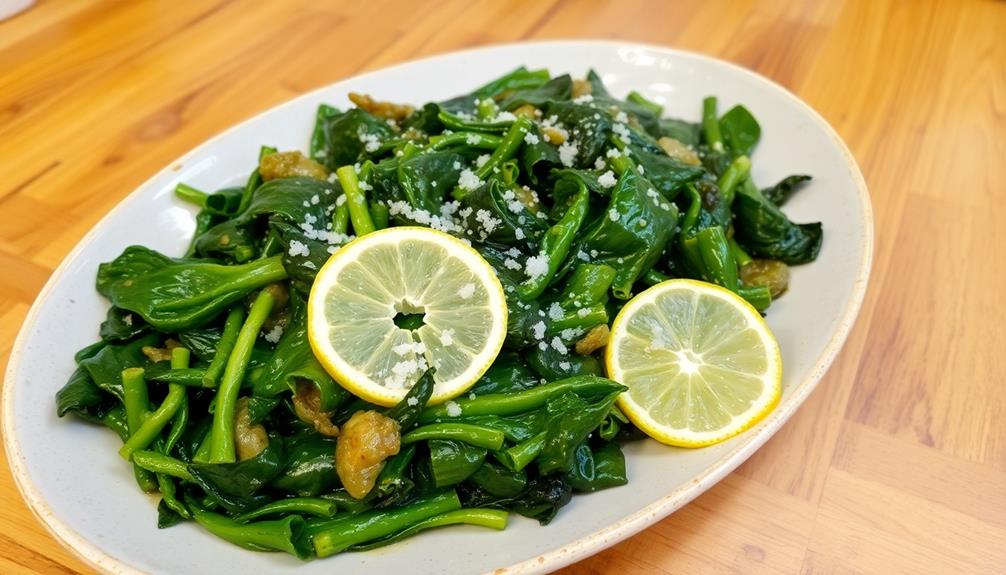
Immediately after seasoning, serve the sautéed horta while piping hot. The vibrant green leaves are at their most flavorful and tender when freshly cooked. Glistening with olive oil and flecked with aromatic garlic and spices, the horta beckons you to take a bite.
Dished up onto plates, the steam rising from the greens fills the air with an enticing aroma. Don't let the horta sit for long – its delicate texture is best enjoyed straight from the pan. Grab a fork and dig in, savoring the earthy, peppery notes in every mouthful. The brine of the feta cheese or the richness of a drizzle of lemon juice provides a delightful contrast to the tender greens. If you’re in the mood for something heartier, pair your horta with a traditional Greek dish like our revithia recipe, a stew made with hearty chickpeas and a savory tomato broth. The combination of the tender greens and the robust flavors of the revithia will leave your taste buds singing. Don’t forget to pour yourself a glass of crisp white wine to complement the meal. Bon appétit!
Embrace the rustic simplicity of this traditional Greek dish. Savor each vibrant, flavor-packed bite before the horta cools. This is a meal to be relished in the moment, a true celebration of nature's bounty.
Final Thoughts
The allure of foraging for wild greens lies not merely in their nutritional bounty, but in the sense of connection to the natural world they evoke. Collecting these bountiful gifts from Mother Nature is a rewarding experience, igniting the senses and stirring the soul.
As you savor the fresh, earthy flavors of horta, you can't help but feel a deep appreciation for the cycles of growth and renewal that sustain us all.
While preparing and enjoying these wild greens, take a moment to reflect on the traditions and wisdom passed down through generations. Imagine the hands that have tenderly harvested these leaves before you, nourishing both body and spirit.
Let their story inspire you to continue this legacy, sharing the joy of foraging with family and friends.
Ultimately, the true value of horta transcends the plate, inviting us to reconnect with the natural world and rediscover our place within it.
Frequently Asked Questions
Where Can I Find Horta in My Local Market?
You can find it in the produce section of your local market, usually near the leafy greens and herbs. It may be labeled as "wild greens" or have a specific name like "dandelion greens" or "chicory."
How Do I Identify Edible Wild Greens?
To identify edible wild greens, look for plants with serrated leaves, stems, and flowers. Check field guides or consult experts to ensure safety, as some wild greens can be toxic. When in doubt, leave it out.
Are There Any Health Benefits Associated With Eating Horta?
Eating wild greens can provide you with numerous health benefits. They're often rich in vitamins, minerals, and antioxidants that can support your overall wellbeing. Incorporating these nutrient-dense plants into your diet can be a great way to boost your health.
Can I Use Cultivated Greens Instead of Wild Horta?
You can certainly use cultivated greens instead of wild horta. While the nutritional profile may vary slightly, cultivated greens can provide similar health benefits. Feel free to experiment with different types of greens to find what works best for you.
How Long Do Freshly Picked Horta Last Before Spoiling?
Freshly picked greens usually last 3-5 days in the fridge. Their shelf life depends on the variety, how you store them, and how fresh they were when picked. Proper storage is key to keeping them crisp and flavorful.
